Joe Biden’s difficult, if not impossible, push for ‘unity’
It will take much more than urging people to welcome opposing views to bridge the political divide in the United States.

In his inaugural address on Wednesday, Joe Biden laid out for Americans the hard truths the country faces as he sees it – among them, a nation ravaged by a pandemic, calls for racial justice, and the rise of political “extremism”. One key solution for dealing with those enormous problems comes down to one word: “Unity”.
“To overcome these challenges – to restore the soul and to secure the future of America – requires more than words,” Biden said. “It requires that most elusive of things in a democracy: Unity. Unity.”
Keep reading
list of 4 itemsBiden administration unveils COVID strategy to ‘rebuild trust’
There is no ‘return to normalcy’
Biden signs orders to end ‘Muslim ban’, rejoin climate deal, WHO
He used the word eight times in the 21-minute speech, which also featured the word “together” seven times.
His remarks are likely welcomed by the 81 million of Americans who voted for him and perhaps by the 57 percent of voters that had a dissatisfied or angry view of the federal government on election day, according to exit polls.
But to many of the 74 million that voted for Donald Trump, this call for unity may ring hollow.
An opportunity
“We need to revive the spirit of bipartisanship in this country,” Biden said during an October speech in Gettysburg, Pennsylvania. He might be onto something.
A Pew Research poll in 2019 showed 58 percent of Democrats said it was more important for a Democratic president “to find common ground with Republicans on policies” and a surprising 45 percent of Republicans said the same about Trump.
As he enters office, Biden has an opportunity to not only speak to those Democrats, but to that significant percentage of Republicans who are open to finding common ground.
A Pew poll released last week shows 64 percent of voters expressed positive views of Biden’s conduct since the election and majorities approve of how he has explained policy ideas as well as his Cabinet picks.
Meanwhile, the same poll revealed Trump left office with a 29 percent approval rating, the lowest of his presidency.
Republicans, for their part, find themselves leaderless and facing a serious internecine battle about the direction of their party: Trumpism versus a return to a more traditional conservative posture. With only 57 percent of Republicans saying they think Trump should continue to be a major political figure, according to Pew, it signals there is a significant number of his 74 million voters willing to hear others out, whether that is other Republican leaders or possibly giving Biden a chance.
Longstanding challenges
That being said, the underlying political polarisation in the US is deep and longstanding – and growing significantly.
Biden would benefit from reflecting on how the country got to this point.
In the mid-1990s, House Republicans, led by then-House Speaker Newt Gingrich, brought to the forefront the kind of political warfare that is pervasive today. He and his fellow Republicans aggressively painted Democrats and Democratic President Bill Clinton as enemies, culminating in Clinton’s 1998 impeachment. Democrats picked up where Republicans left off during the George W Bush presidency from 2001-2009, and then Republicans accelerated the partisan warfare during the Obama years.
By 2016, Democrats’ and Republicans’ very unfavourable views of the opposite party had tripled since 1994, according to Pew, with more than half viewing each other very unfavourably in 2016.
Trump tapped into that split and instead of preaching unity, he exploited the divisions while also appealing to those Americans – independents, older voters, white women, working-class white voters – who had been inclined to occasionally support Democrats but had felt Obama and other Democrats were not speaking to them.
As Biden preaches “unity”, it reminds me of a story Democratic Senator Amy Klobuchar told me in 2017 about why Hillary Clinton lost several midwestern Democratic strongholds and almost lost Klobuchar’s state of Minnesota to Trump in 2016. She said that Clinton’s slogan “Stronger Together”, while preaching unity, fell flat to voters disaffected by Democrats in Washington, DC.
“To out of work steelworkers in Minnesota, that was ‘everyone together but me’,” Klobuchar said.
That is the crux of Biden’s challenge: How does he speak to those disaffected Americans – many of whom became disaffected during the Obama-Biden administration? What does he say in the coming months to those who have grown distrustful or even angry at Democrats over economic, social, political, or even racial issues? In addition, what actions will he take as president to soothe those concerns before beginning his attempt to woo their support?
“I know speaking of unity can sound to some like a foolish fantasy these days,” Biden acknowledged before offering some suggestions on how to begin bringing Americans together.
“We can see each other, not as adversaries, but as neighbours. We can treat each other with dignity and respect. We can join forces, stop the shouting and lower the temperature,” he said.
White House Press Secretary Jen Psaki on Wednesday said Biden has already started that process.
“He has reached out to, not just Democratic members of Congress, but also Republicans. Not just Democratic governors, but also Republicans. Not just Democratic mayors, but also Republicans,” she said.
“And that, of course, has to be backed up by actions,” Psaki added, which is the biggest challenge Biden faces in his quest for unity.
But if Biden fails to convince angry, pessimistic and sceptical Americans that his policies are not deeply partisan and fails to speak in a way that brings in the politically disillusioned, then his quest for unity could wind up being a “foolish fantasy” after all.